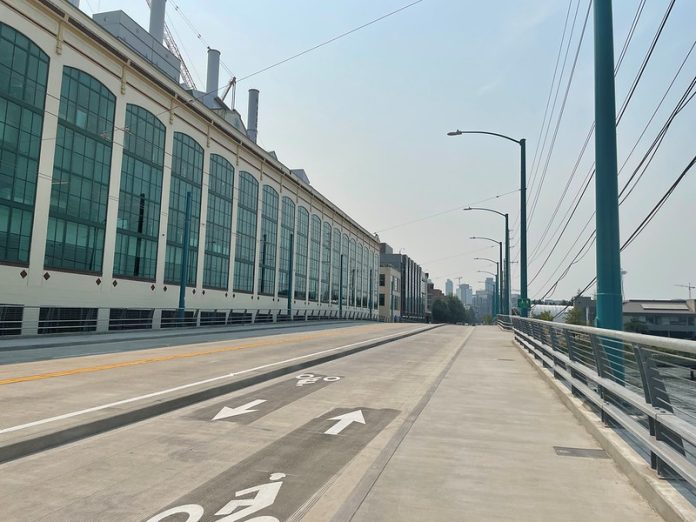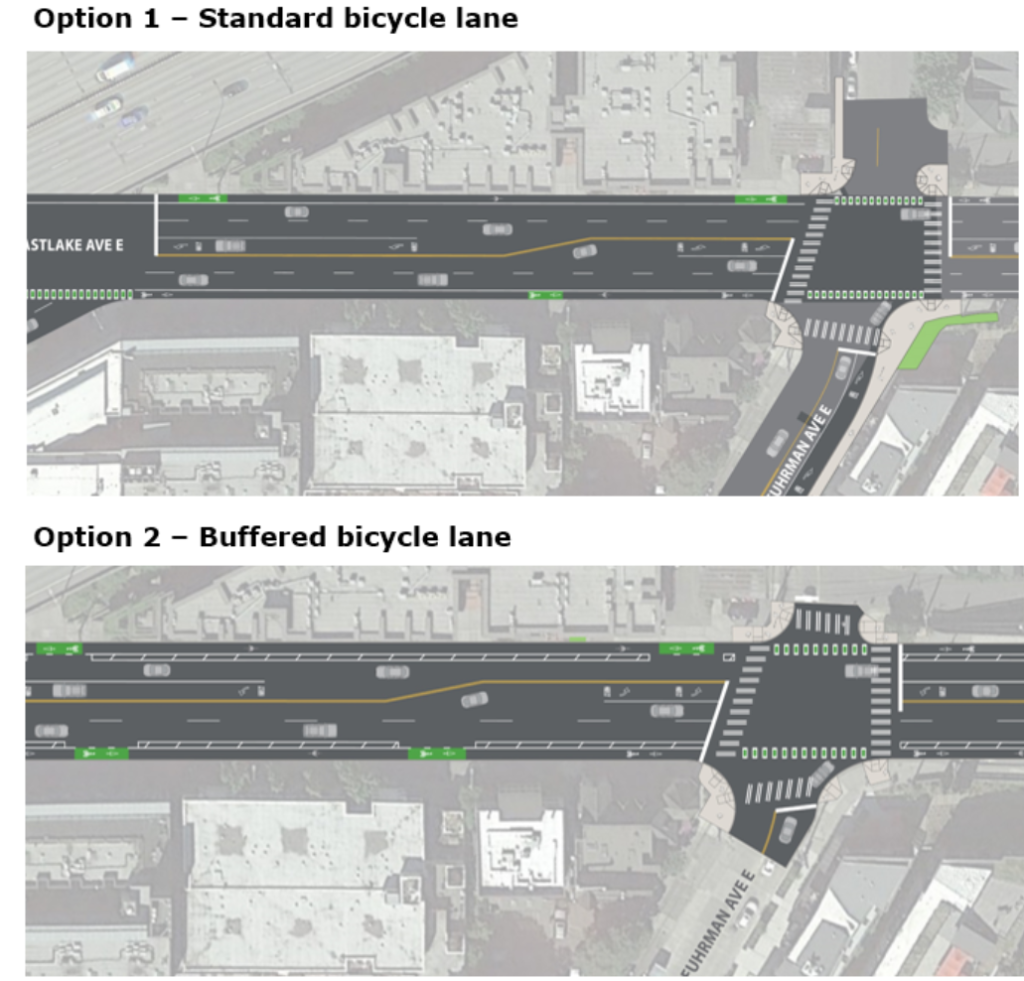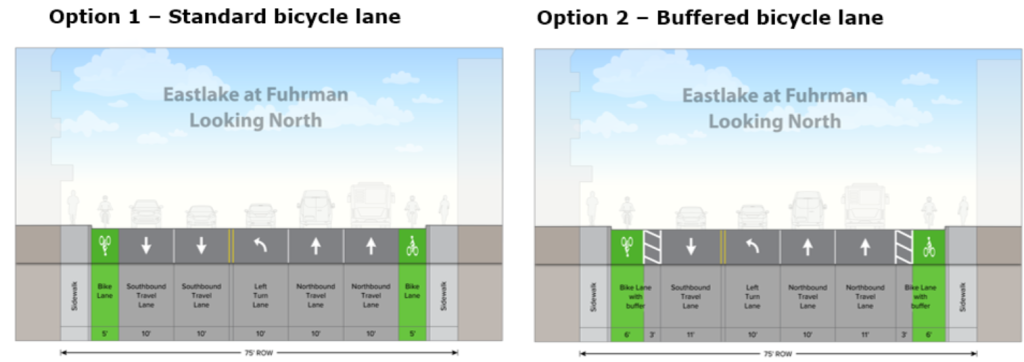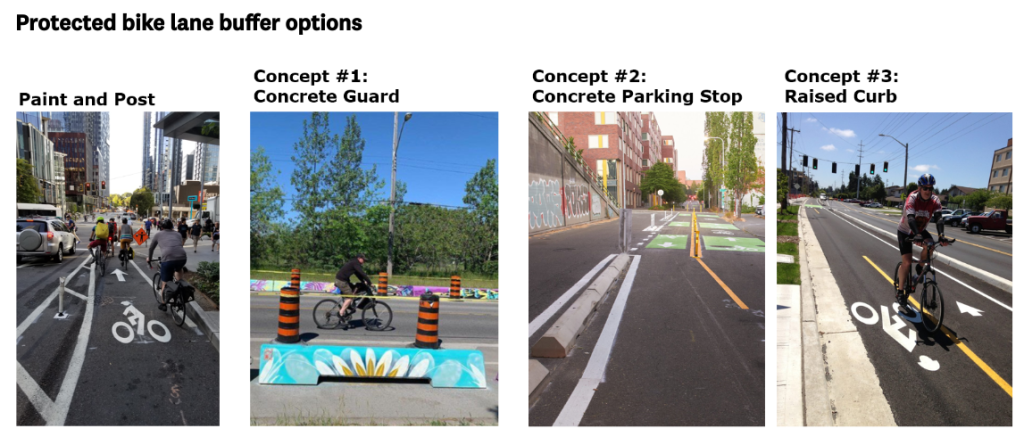
The Seattle Department of Transportation (SDOT) is starting its next round of public outreach around the RapidRide J line, a planned transit upgrade for the current Route 70 between Downtown and the University District. In the works since 2014, the project is heading toward full design and it is expected to break ground in late 2023 or early 2024. This round of outreach includes a new survey, asking respondents about specific elements of the project, most of them involving the protected bike lanes that the project will add to the corridor.
That bike lane is certainly the most controversial element of the $91.2 million project. Filling a monumentally important gap in Seattle’s bike network, the city is prioritizing space along Eastlake Avenue E to provide a separated connection for people biking, with space created by removing parking spaces on both sides of the street. Pushback from some in the Eastlake neighborhood has been considerable. SDOT spent years evaluating their inclusion, ultimately concluding that there wasn’t an alternative that could provide the same outcomes for the city’s bike network.
The most notable part of the survey is the fact that SDOT is reconsidering the design of the bike lane directly south of the University Bridge, between Harvard Avenue E and Fuhrman Avenue E. Previously, designs for the project retained five vehicle lanes through this segment (none dedicated transit lanes), leaving no room to provide protection to the existing narrow, paint-only bike lanes along the curb.
“Because of the narrow width of the roadway in this section, and in order to accommodate all modes, the concept design plans do not include the three-foot buffer that is included along the majority of the new protected bike lanes along Eastlake Ave E,” an email sent earlier this year by the project team stated. But it looks like doing this segment right is still on the table.

The survey includes an option that would only retain one southbound travel lane south of Furhman, which makes sense because the two travel lanes coming off the bridge split into one turn lane onto Fuhrman and one continuing onto Eastlake. In 2019, around 40% of the traffic on the bridge came to or from Fuhrman. But just a few months ago the project team was saying it wasn’t possible. The option that takes a travel lane for a bike lane buffer doesn’t show any type of barrier, unfortunately, but taking space for the buffer would enable a barrier to be added sometime down the line if SDOT’s (bizarrely) not proposing one here.

The survey also asks for input on a spot in the University District. Coming north from the University Bridge, the protected bike lane will be on the right side of 11th Avenue NE, but at NE 43rd Street it’s planned to switch to the left side. SDOT is asking for feedback on that transition. Option 2, the only one that includes a diagonal crossing, seems to be most similar to what the department has done elsewhere, while Option 4 gets close to looking like a fully protected intersection.
In 2020, when the RapidRide J was shortened to terminate at the University District light rail station instead of at Roosevelt, due to budget shortfalls, adding a northbound bike facility that also connected to NE 65th Street to provide a counterpart to the southbound one on Roosevelt Way was also taken off the table. But SDOT as recently as this week confirmed plans to fully build that connection. But it’s not completely clear why the bike lane would be on the left side of 11th north of 43rd; right now there’s a paint bike lane on the right side. Moving it would eliminate conflicts with buses on the street, but adds this awkward transition that is becoming incredibly common on Seattle’s streets.

One of the more frustrating parts of the survey is a question about the barrier type on the planned bike lane. Noting that a paint-and-post design was already included as the project’s base design, SDOT is asking whether respondents would prefer a concrete curb instead. Given the department has started to upgrade paint-and-post bike lanes around the city via its Even Better Bike Lane project, most recently adding curbs to the nearby NE 40th Street bike lane in the University District, it’s puzzling to see SDOT asking about upgrading the bike lane here before it even goes in. The survey mentions higher cost for concrete barriers; why not evaluate that in terms of the project’s funding and propose the best type available? Asking people whether they want their bike lane protected to the fullest extent possible is just frustrating.

This survey serves to emphasize some of the project elements that appear to be set in stone, like the full bike lane on Eastlake, despite the efforts of many, including Councilmember Alex Pedersen (District 4), to water them down. As the design phase of the project inches toward completion, SDOT appears to be answering some of the biggest outstanding questions and thankfully, in the case of the segment south of the University Bridge, revisiting some prior assumptions.
But by the time this project is completed, in 2026, it will have lived through four or five mayors and taken 13 years. Here’s hoping this is the last survey that anyone has to complete on the RapidRide J Line, ever.
SDOT is hosting a virtual meeting this Wednesday, September 14, at both 12pm and 6pm, to provide an update on the project and gather feedback. You can RSVP for either meeting on the project’s website.
Ryan Packer has been writing for The Urbanist since 2015, and currently reports full-time as Contributing Editor. Their beats are transportation, land use, public space, traffic safety, and obscure community meetings. Packer has also reported for other regional outlets including Capitol Hill Seattle, BikePortland, Seattle Met, and PubliCola. They live in the Capitol Hill neighborhood of Seattle.


